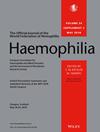Treatment and Disease Burden in a Cohort of People With Haemophilia Without Inhibitors in the United States
Abstract
Introduction
Haemophilia is a bleeding disorder caused by a deficiency in coagulation factors VIII or IX. Great advances in haemophilia treatment have been achieved in recent decades, with a range of products for prophylaxis now available, the ability to individualise therapy, and resultant improvements in life expectancy and quality of life. Despite these advances, there remains an unresolved burden, both from the disease and its treatment. Real-world data provide an opportunity to understand the experiences of people with haemophilia and gain insight into the areas of greatest unmet need.
Aim
To assess the treatment and disease burden of haemophilia using real-world data.
Methods
Medical records data and patient-reported outcomes from a self-selected cohort of 446 people with haemophilia without inhibitors across the United States were combined using an online research platform. Participants’ treatment and disease burdens were assessed using the Hemophilia-Treatment Experience Measure (Hemo-TEM) and the patient-reported outcomes measurement information system (PROMIS)-29, respectively. Results were stratified by haemophilia type and disease severity.
Results
These real-world data indicated that treatment and disease burden are experienced by people with haemophilia regardless of treatment regimen or severity of disease. The domains most affected by treatment burden were physical impact and emotional impact; the domains most affected by disease burden were physical functioning, pain interference, depression and anxiety.
Conclusion
This underscores how the perspectives of people with haemophilia in real-world settings represent a valuable adjunct to clinical trial data. Such insights can potentially contribute to guide individualised treatment options and help address current unmet needs.


 求助内容:
求助内容: 应助结果提醒方式:
应助结果提醒方式:


